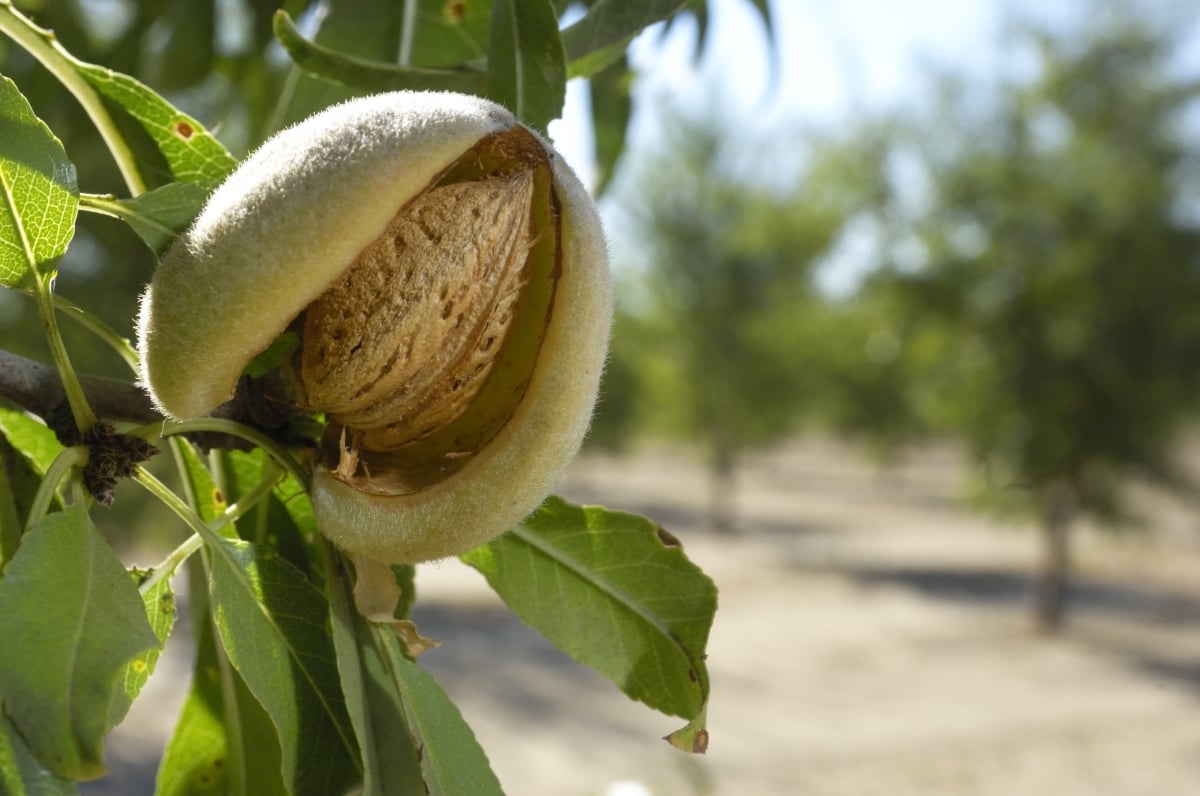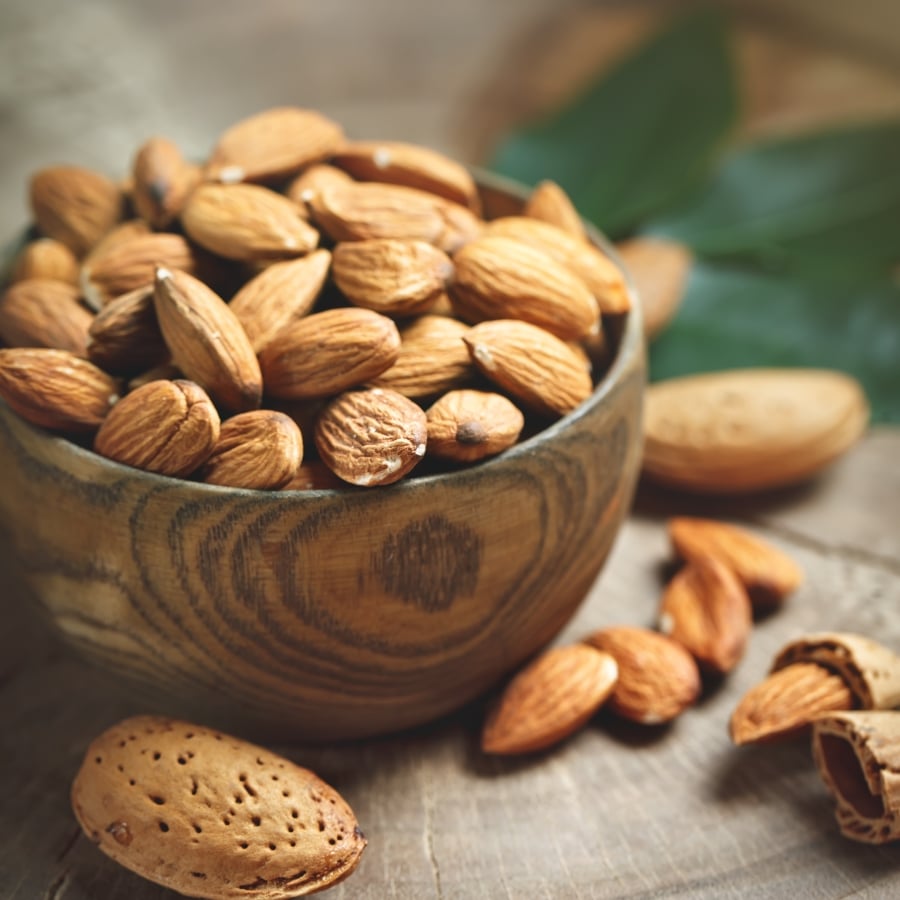Countless, sweet-smelling pink and white petals bloom on more than a million acres of almond trees across California in late February and March. It’s a captivating experience and many compare it to the blossoming of cherries.
Locals call the falling flowers “the valley snow.” And several months later, from mid-August to October, “shaker” machines shake billions of pounds of almonds to the ground, where they dry in the sun before they’re swept into rows, picked up, and processed.
California grows close to 100% of commercial almonds in the U.S. and 81% of almonds worldwide. And the global almond demand is rising at a rate that exceeds the supply.
Almonds are an easy, healthy snack. Almond milk has become more popular than soy milk in the U.S. (even though some store-bought almond milk may contain only about 2% almonds). And other almonds products, like almond butter and flour, are also increasing as the demand for plant-based products continues to rise.
Almonds are nutrient-dense and healthy. They’re high in protein, vitamins and minerals, antioxidants, and healthy fats. And they have some proven health benefits, such as reducing heart disease and type 2 diabetes.
But are almonds a sustainable choice? Or are they “ruining the environment” as some are saying?
Why Are Almonds Grown in California?
Mediterranean climates, like California’s, have mild, wet winters and warm to hot, dry summers. These are the ideal growing conditions for almonds.
The state also has fertile soils, natural resources and infrastructure, and innovative research and technology. All of which makes California one of the most optimal places on the planet to grow almonds.
California is also the most productive agricultural state in the United States, and one of the most productive in the world. After California, Spain and Iran are the next largest almond growers. Other top almond producers include Morocco, Syria, Turkey, Italy, and Australia.
Are Almonds Bad for the Planet?
If you Google “are almonds environmentally friendly,” you’ll see results about why you “should ditch the almond milk,” “the dark side of almond use,” “are you nuts to keep eating almonds?” and other similar headlines.
Most of the arguments focus on the water almonds need. But how much water do almonds actually use? And is this as big a problem as some make it out to be?
How Much Water Do Almonds Need?
A single almond takes about 1.1 gallons of water to produce. Or close to 10 gallons for a handful.
California dedicates about 8% of its total agricultural water supply to growing almonds.
Almond trees need water year-round, even when they’re not producing almonds.
And more almond trees are being planted in California, with the number of almond orchards doubling in the last 20 years.
The Truth About Almonds and Water Use
The water almonds need became a topic of concern during the California drought from 2012 to 2016, the worst one on record since 1895. Governor Jerry Brown declared a drought emergency for the state.
During this time, many websites published stories about almonds and almond milk.
But according to research published in 2017 in the Journal of Ecological Indicators, almonds’ water footprint in California has to be put into context. The study’s author says it’s important to consider the water use and the benefits that come with that water use.
The authors compared the nutrition content of 42 different California food crops. They also ranked the economic value of 44 food crops. They concluded that for the water needed to produce them, almonds ranked among the most valuable foods grown in California for their dietary and economic benefits.
In fact, almonds ranked at or near the top of all California crops in seven of the 11 nutrient categories. And walnuts and pistachios ranked similar to almonds for their water use.
The California Agricultural Issues Center says the California almond community delivers significant economic value to the state. Almonds support 104,000 jobs across California and contribute $11 billion annually to the state’s GDP.
Why California’s Real Water Problem Isn’t Almonds
So, yes, California produces a lot of almonds. And these almonds require a lot of water. But the state is a leading producer of another product that uses even more water… and that’s dairy.
In fact, per cup, almond milk is actually less water-intensive than cow’s milk. Companies like Blue Diamond and Silk contain approximately 38 almonds in a half gallon of milk. So, if each almond takes about 1.1 gallons of water to grow, then it takes about 84 gallons of water to produce the almonds used in a typical store-bought gallon of almond milk. By comparison, it can take up to 880 gallons of water to produce a gallon of dairy milk.
Plant-based milks not only typically need less water than dairy, but they also have a smaller carbon footprint. Almonds are estimated to have a carbon footprint 10 times smaller than that of dairy milk.
California is also a major producer of beef. And both dairy and beef cows use a huge amount of water. In fact, a single pound of beef requires a whopping 1,800 gallons of water. Around one-third of the state’s entire water budget is used to produce meat and dairy. Stunningly, California’s livestock industry uses more water than all the homes, businesses, and government in the state combined.
Additionally, California cows are responsible for 45% of the state’s methane emissions, and methane is an especially potent greenhouse gas.
Last time I checked, almonds didn’t burp or fart, so they don’t emit methane.
And Then There’s Alfalfa
Alfalfa consumes the most water of any crop in California. This green crop sucks up 15% of the state’s irrigation water.
You may not have eaten alfalfa or seen it in your grocery store (except maybe as alfalfa sprouts). But meat eaters consume lots of alfalfa… after it is cycled through livestock. Some of that alfalfa gets exported, too.
California, it turns out, exports more than 100 billion gallons of water per year in the form of alfalfa to countries like China, who use it for livestock feed. How much sense does it make, in a state that can face devastating water crises, to — in effect — ship away one-third of the water to meet the needs of every household in the city of San Francisco, so China can eat more beef?
So, are almonds really California’s top water concerns? Or should the focus be reducing dairy and beef consumption and production?
Water Progress and Solutions for Almonds

Even though meat and dairy might present a bigger problem, there’s no question that almonds are a thirsty crop. And providing 82% of the world’s almonds is a tall order for any state.
In response to the recent drought, the state’s almond farmers have been working to improve their water efficiency. And progress is being made: California almond farmers have reduced the amount of water it takes to grow one pound of almonds by 33% over 20 years.
And by 2025, the California almond community commits to reduce the amount of water to grow a pound of almonds by an additional 20%.
Nearly 80% of farmers across the state use efficient microirrigation systems, which conserve water by applying it where the crop needs it rather than to the entire field.
And the Almond Board is exploring if almond orchards can help replenish underground aquifers (which are used for drinking water and agriculture). Through a process called groundwater recharge, orchards are purposely flooded when water is available to allow the water to filter gradually into the aquifers.
Almonds Begin Because of Bees
Almonds’ sustainability story doesn’t end with water.
For these nuts to grow, bees must pollinate each blossom. Almond orchards are the first natural food source of the year for many bees after winter hibernation.
Bees store this food to start their pollination season. According to the Almond Board of California, almond pollen is nutritious, providing all 10 of the essential amino acids bees need.
In total, California’s almond industry requires roughly 2 million hives — it’s the world’s largest managed pollination event.
Almost all the bees are brought to the state from across the country. More than 68% of all commercial honey bee colonies in the United States are used to pollinate almond orchards.
And in case you don’t know, bees are in trouble. Bee numbers are declining for a number of factors, one of which is pesticides. And many of the bees in California are dying from pesticides used on almond groves.
The USDA Pesticide Data Program has found nine different pesticide residues in almonds — and four are toxic to honey bees.
What About Organic Almonds? Are They More Sustainable?
Organic crops use less pesticides. And that’s a very good thing for the bees!
Unfortunately, there are only a few million acres of almond groves that are currently certified organic in California. But in response to consumer demand, more and more farmers are choosing to make the switch.
Chris and Marcie Baugher of Baugher Ranch Organics in Northern California have been marketing organic almonds for 30 years and have helped pioneer the organic almond industry.
Their 640 acres features natural water reservoirs, ponds for collecting water runoff, and natural habitat surrounding their orchards. They also promote bee activity by planting bee-friendly native pollinators around their orchard sites.
The Burroughs are another farm family. They grow nearly 1,000 acres of organic almonds in California’s Central Valley:
They say that despite challenges, going organic is the best decision they’ve ever made, and they won’t go back.
As Ward Burroughs says in the video, “You cannot improve the health of this world if you’re gonna continue to put poisons and toxins on it to produce your food.”
If You Choose to Eat Almonds…
When purchasing almonds and almond milk, there are some good reasons to go organic if you can. Certified organic almonds are grown without pesticides, which makes them more bee-friendly. And they often use less water, too.
If you want to drink almond milk, you might want to try making your own. Most commercial almond milks are low in actual almonds and high in thickeners, flavorings, and sugars. Homemade recipes call for a lot more almonds than store-bought varieties, so you can get more of their health benefits). And you’ll eliminate the packaging and food miles. (For more on plant-based milk options, click here.)
If you want to try making your own almond milk at home, consider one of these easy to follow recipes:
Plain Almond Milk (with optional varieties)
Minimalist Baker posted a simple “How to Make Almond Milk” recipe on her blog with an accompanying video. She even includes whole food ingredients like cocoa powder or berries if you want to make chocolate almond milk or berry-infused almond milk.
Vanilla Cinnamon Almond Milk
For a delicious, homemade spin on the conventional vanilla almond milk found in stores, give this Vanilla Cinnamon Almond Milk from Oh She Glows a try. The combination of Medjool dates, vanilla bean, and powdered cinnamon combine for just the right amount of natural sweetness with a little bit of spice.
And Then There’s the “Almond Cow”
You can also get a useful machine to make the process even easier. The Almond Cow is a plant-based milk maker that allows you to create milk from any nut, seed, or grain in minutes with easier cleanup and no nut milk bags required. The machine uses a cold blending process to protect the nutrients, so it doesn’t apply heat. You can check it out here. (Use the code FOODREVOLUTION for a special discount.)
Tell us in the comments below:
-
What do you think about the sustainability of almonds?
-
Do you eat almonds? Does their environmental impact concern you?
Featured Image: iStock.com/Anna Usova




